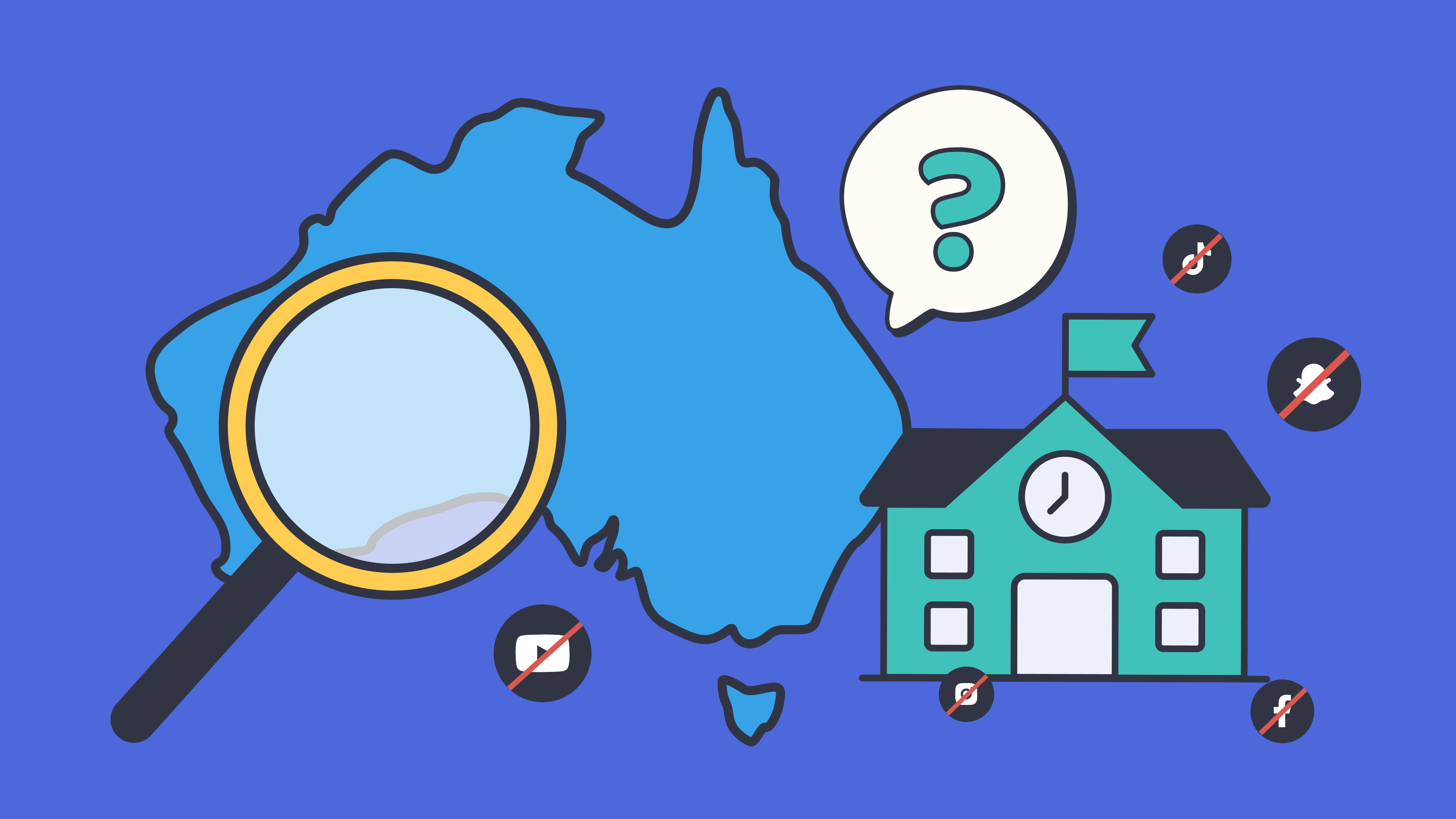Should Scotland be watching Australia’s social media ban?
As school leaders, we all want to create safe, focused, and positive learning environments, both offline and online. But in a world where YouTube and TikTok are only a tap away, and algorithmic platforms can shape everything from pupils’ friendships to their worldview, are we doing enough to protect them?
Australia is making history, announcing a nationwide restriction preventing anyone under 16 from holding accounts on YouTube, TikTok, Instagram, Facebook, X, Reddit, and Snapchat. Meanwhile, education systems around the UK are reviewing how best to protect learners online while ensuring technology continues to enhance learning.
In Scotland, these same questions are highly relevant. Schools are already working within national priorities set out in the Digital Learning and Teaching Strategy for Scotland, alongside guidance on Cyber Resilience and Internet Safety from the Scottish Government and Education Scotland. Together, these frameworks highlight the importance of teaching digital literacy, keeping learners safe, and ensuring that technology use in schools supports wellbeing as well as attainment.
The big question for school leaders in Scotland is this:
If Australia can take that bold step, should we be doing the same, at least in our classrooms?
In this article, we explore why Australia is making the bold move to restrict social media, including YouTube, for under-16s, what can Scotland learn from this, what are some practical steps educators can take and what are the safer alternatives.
Safeguarding and digital learning in Scotland
Recent Scottish policy developments continue to place online safety and digital wellbeing at the heart of safeguarding practice. The National Guidance for Child Protection in Scotland (2021) and the Cyber Resilience and Internet Safety Framework both emphasise the need for schools to address emerging online risks, including misinformation, conspiracy content, and algorithm-driven exposure to harmful material, alongside robust filtering, monitoring, and digital literacy education.
These frameworks recognise that unregulated video platforms, where content is recommended rather than chosen, present real safeguarding challenges. Schools are therefore encouraged to ensure that digital learning remains structured, age-appropriate, and purposeful, using trusted educational platforms that align with the Digital Learning and Teaching Strategy for Scotland.
Put simply, Scottish guidance expects schools to take a proactive, preventative approach to online risk — helping children build the skills and resilience they need to navigate the digital world safely and confidently.

Why is Australia making a bold move to protect under-16s?
From 10 December 2025, Australia will become the first country in the world to restrict under-16s from logged-in access to major social media platforms, including YouTube.
This “social media delay” follows mounting evidence that children are being exposed to harm long before they are developmentally ready. In one Australian national study, 40% of children’s most recent exposure to online harm was via YouTube, including violent, extremist, or eating disorder content.
ClickView, in an effort to support and inform educators across Australia, recently invited experts, including Sarah Darcy, Assistant Director of Digital Education from ACT Government, and Dr Danielle Einstein, Clinical Psychologist and Adjunct Professor at Macquarie University, to provide their views and expertise on the social media delay. Both of them, based on their experience and research, supported the e-Safety commissioner’s recommendations.
As Sarah Darcy explained, “YouTube is immensely useful, but it wasn’t built for schools. It was built to maximise clicks and attention. Our job now is to help schools create safe, compliant pathways to its content.”
According to Dr Einstein, YouTube’s harm extends beyond distraction, weakening wellbeing, distorting friendships, and amplifying social pressures. She cited cases where manipulation by influencers pushed vulnerable children towards disordered behaviour. The eSafety Commissioner (2024) echoed this, citing how addictive platforms distort norms, fuel harmful subcultures, and damage academic performance.
Dr Danielle Einstein added, “YouTube was designed for education and entertainment, but its delivery has become addictive like other platforms. Students skip to main points, attention spans drop, and the rise in addictive use undermines community, increases anxiety, depression, and insomnia.”
In her starkest warning, she continued to say, “The lack of regulation makes YouTube a wild west. Students rarely check sources, but the platform rewards attention, not truth. That has real consequences for their mental health and their ability to learn.”
Why YouTube still poses risks, even when logged out
Even without logging in, YouTube’s algorithm continues to recommend harmful or extreme content.
Tests by independent researchers found that under-16 users were served gambling, far-right, and violent videos within minutes of watching neutral clips (The Guardian, Sept 2025).
This means that while account restrictions are a step forward, the logged-out version of YouTube remains far from safe.
Educators in Australia, and increasingly in Scotland, are questioning whether algorithm-driven platforms belong in the classroom at all.

Should Scotland follow suit?
With Australia taking decisive action, senior leaders in England must ask:
- Are we relying too heavily on open, ad-funded platforms like YouTube for teaching?
- Do we fully understand the safeguarding implications of algorithmic video content?
- Should we act now to reduce reliance, before future legislation makes it mandatory?
When teachers use YouTube in class, pupils perceive it as “school-approved.” Even with Restricted Mode, autoplay and sidebar recommendations still expose children to ads, clickbait, and misinformation. In a TeacherTapp survey, 73% of UK teachers have encountered inappropriate, embarrassing, or unsafe content when using YouTube in the classroom. The convenience of free content has come at a growing cost to student focus, well-being, and safety.
As Dr Einstein noted, the social media delay isn’t about taking opportunities away, it’s about giving young people a healthier start. “Genuine friendships aren’t lost because of a ban. The addictive element of likes and followers is what’s being challenged. Creativity and connection can thrive offline. Being a little bored sparks imagination and reduces anxiety.”
Practical steps for Scottish schools
Schools that want to go beyond compliance and follow Australia’s protective lead can:
- Reference the risks of open-access video platforms explicitly within their Cyber Resilience and Internet Safety (CRIS)and Digital Learning policies.
- Limit or remove pupil access to YouTube and similar services on school networks, ensuring that filtering and monitoring meet the expectations in the National Guidance for Child Protection in Scotland.
- Encourage staff to use curated, ad-free educational video platforms that align with the curriculum.
- Use PSE and assemblies to teach pupils how algorithms influence attention, wellbeing, and beliefs.
- Provide guidance for parents on safe alternatives and home filtering, signposting national resources such as ThinkUKnow Scotland and 360 Safe Scotland.

Best practices and safer alternatives
The Australian experience shows that moving away from open platforms doesn’t mean sacrificing creativity; it means curating it safely.
ClickView also conducted a national survey of schools in Australia ahead of the delay, with 433 schools responding. They found that only 7% felt prepared for the changes, yet 72% wanted access to safe, curriculum-aligned video content. Teachers also called for tools that help them embed videos, filter content, and communicate with parents about online safety.
ClickView’s Education expert Tara Walsh described how educators have been proactively requesting YouTube content to be added to trusted, vetted educational platforms. She added,“Teachers are submitting requests for specific videos, and our team is vetting and adding them directly. That way, schools retain access to the content they value, without the risks that come with open social platforms.”
These emerging practices offer a blueprint for UK schools: replacing algorithmic feeds with curated, ad-free, curriculum-aligned libraries that protect pupils while maintaining engagement and creativity.
What Scotland can learn
Scotland already has the policy framework to act. The National Guidance for Child Protection in Scotland (2021), the Cyber Resilience and Internet Safety Framework, and the Digital Learning and Teaching Strategy for Scotland all place online safety and wellbeing at the centre of education. Australia’s example gives the moral imperative. Together, they signal a shift in how we define digital learning safety.
As Sarah Darcy advised, “Go beyond compliance, aim for best practice in digital citizenship. This is an opportunity to reflect and take positive steps forward.”
And Dr Einstein concluded, “Australia is leading the world in recognising the dangers of social media for mental health. This is a positive step; small changes now can make a huge difference.”
For Scottish schools, those small changes could mean rethinking where and how video fits into the classroom. The question isn’t just should we follow Australia’s lead? It’s how long can we afford not to?
Conclusion: Mitigating algorithmic risk to build safer, smarter classrooms
The rise of misinformation, addictive design, and AI-generated content has made it clear that unregulated social media platforms are no longer safe spaces for learning. Both Scottish policy and Australia’s forthcoming Social Media Delay highlight the urgent need for schools to reassess their reliance on platforms like YouTube, TikTok, and Instagram.
While Scotland’s guidance stops short of age-based restrictions, it reinforces a crucial message: schools must take proactive responsibility for digital safety. That means going beyond filtering and monitoring, toward creating truly safe, purposeful digital learning environments.
This is where ClickView provides a trusted, ready-to-implement solution. Its curriculum for Excellence aligned, ad-free, and educationally vetted video library allows schools to embrace digital learning without the risks associated with algorithm-driven content. ClickView integrates seamlessly with safeguarding frameworks, supporting:
- Compliance with policy through safe, school-approved video resources.
- Protection from disinformation and harmful content, ensuring all materials are educationally verified.
- Practical training for staff and pupils, helping embed critical digital-literacy skills and wellbeing awareness.
- Filtered, closed access, a safer alternative to open social platforms.
As Australian experts remind us, this isn’t about restricting creativity, it’s about curating it responsibly. By shifting from algorithmic feeds to trusted educational platforms, Scottish schools can protect students, uphold compliance, and lead the way in shaping a safer, smarter future.
Interested in safer video learning for your school?

Michael Wilkinson
briefcase iconManaging Director
Michael Wilkinson is the UK Managing Director of ClickView, an award-winning curriculum resource, trusted by over 7,000 schools and colleges. ClickView is home to a wide range of curriculum-aligned video content, plus the best educational documentaries, TV series and feature films, improving student engagement, reducing teacher workload and enhancing learning.
Other posts
Want more content like this?
Subscribe for blog updates, monthly video releases, trending topics, and exclusive content delivered straight to your inbox.






